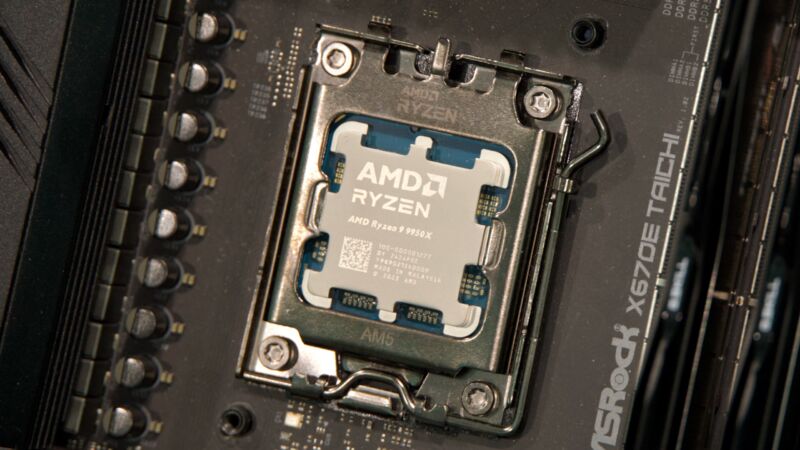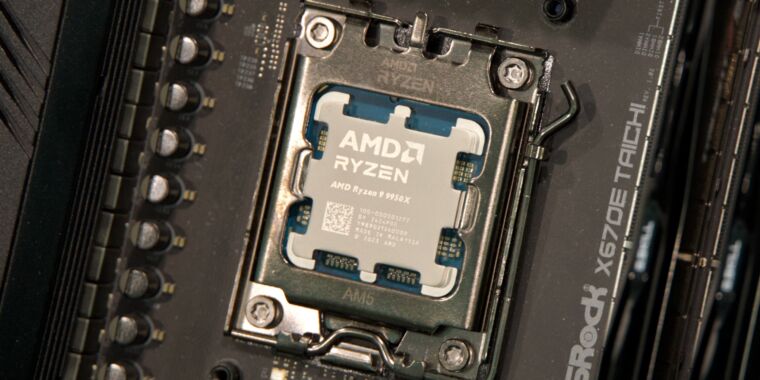AMD Ryzen 9000 review: Impressive efficiency, with bugs and so-so speed boosts

Andrew Cunningham
Nearly two years after the release of the first Ryzen 7000 CPUs, AMD has returned with a full-fledged follow-up. The new Ryzen 9000 chips—the 6-core 9600X, 8-core 9700X, 12-core 9900X, and 16-core 9950X—bring AMD’s new Zen 5 architecture to the desktop a couple of weeks after it launched in the Ryzen AI chips for laptops.
We came away from the cumbersomely named Ryzen AI 9 HX 370 impressed by both its performance and its power efficiency, and AMD is also leaning into power efficiency as a key selling point of the Ryzen 9000 series. Three of the chips have seen their power limits dropped significantly compared to last-gen chips while still bragging of low-double-digit performance increases. That’s rare at a time when Intel has been pushing its chips to the edge to squeeze every last bit of performance out of high-end Core i9 and Core i7 chips.
The focus on power efficiency will give many users—particularly those who don’t touch the default settings—less-power-hungry chips that run a bit cooler. And for people who want to tinker and trade in some of that efficiency for a performance boost, many of these chips (particularly the 9700X and 9900X) have a lot of additional performance headroom. It’s also nice that all existing AM5 motherboards on the market should be compatible with the 9000 series once a BIOS update is installed, and the AM5 platform’s mandatory BIOS Flashback support means you don’t need to use weird, kludgy hacks like the “boot kit” CPU loaner program for updating the BIOS when you buy a board with an older BIOS installed.
But it’s not all smooth sailing. Motherboard and RAM costs remain an issue across the entire AM5 platform nearly two years after launch, especially for budget buyers. Launch pricing is high, especially compared to current street prices for the 7000 and 7000X3D series CPUs. And we ran into a few bugs during testing that may also bite other early adopters while we wait on AMD and the motherboard makers to straighten things out.
Meet Zen 5
Compared to the Ryzen 7000 launch, when AMD was putting out new CPUs, a new architecture, a new I/O die (IOD), new chipsets, a new integrated GPU, (mandatory) DDR5 support, and a brand-new processor socket all at once, the Ryzen 9000 launch is downright placid. The IOD is the same. The integrated RDNA2-based GPU is the same (and, it’s worth reiterating, not at all intended to play games). The AM5 socket is the same. Officially supported DDR5 speeds are up a bit, from DDR5-5200 to DDR5-5600. But the widespread availability of and support for factory-overclocked RAM in desktop motherboards means that a modest bump to officially supported RAM speed doesn’t mean all that much; AMD still recommends DDR5-6000 for optimal performance.
There are new 800-series chipsets, but they’re so incrementally improved over the old 600-series chipsets that AMD didn’t even send along a new motherboard with the new processors. We were directed to install a new BIOS update on existing X670E boards from the Ryzen 7000 launch instead (this almost never happens, even when forward compatibility is a selling point). This seems like a subtle signal from AMD—don’t feel like you need to wait for or pay extra money for a newer motherboard, something that would only increase the AM5 platform’s stubbornly high base price.
This leaves us with only two new things of note: the Zen 5 architecture itself and the new core chiplet die (CCD) that combines up to eight Zen 5 cores together.
Ryzen 9000’s Zen 5 CCD is built using TSMC’s N4P process, an upgrade from the 5 nm process used for the Ryzen 7000 series. TSMC says that N4P is 22 percent more power efficient than the 5 nm process, which is part of what is enabling AMD to use a lower TDP for most of the Ryzen 9000X CPUs while still providing faster performance.
It also probably has at least a bit to do with the lower operating temperatures of Ryzen 9000, which AMD has said should be about 7° Celsius lower than equivalent Ryzen 7000 CPUs at the same power levels. Ryzen 7000X chips running at their default TDPs ran a bit hot, and while AMD said this was normal and safe behavior, a cooler chip will usually offer better consistency and longevity.
A major architectural change from Zen 4 relates to support for AVX512 extensions, which Intel introduced (infamously, in some circles) in 2017 with some of the higher-end Skylake variants but hasn’t enabled on recent consumer CPUs because Intel’s E-cores don’t support them. Zen 4 brought AVX512 instructions to Ryzen CPUs for the first time, but it did so by combining two 256-bit data paths. Zen 5 has a full 512-bit data path for AVX512 instructions, and for the (still rare-ish) tasks that actually use AVX512, it gives Zen 5 a disproportionately high performance boost.

